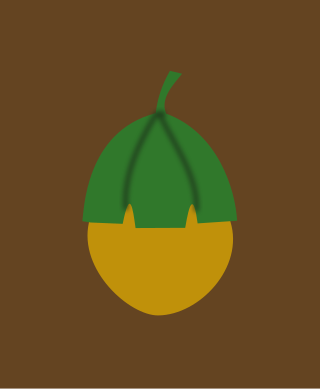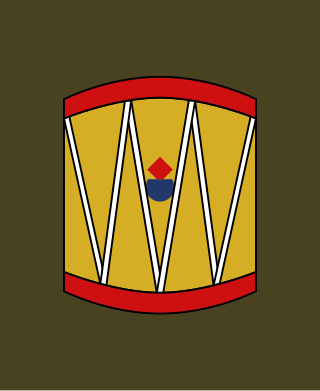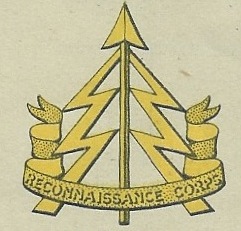
The Devon and Cornwall County Division was a County Division of the British Army created during the Second World War. It was formed on 28 February 1941, from recently recruited soldiers, in response to the renewed threat of a German invasion. The 10,000-strong division was a static formation, lacking transport, intended to defend possible landing sites along the southern Cornish and Devon coastlines from invading German troops. The creation of the division also helped to free up the more experienced troops, who were then held back from the coastline to be able to launch a counterattack against any potential German landings.

The Durham and North Riding County Division was a coastal defence formation of the British Army during the Second World War. It existed only from 12 March 1941 until 1 December 1941, when it was redesignated Durham and North Riding Coastal Area and the subordinate brigade headquarters were disbanded. Most of the infantry battalions were then converted to other roles with the Royal Artillery or the Royal Armoured Corps. In its short existence the division had just one general officer commanding, Major-General P. J. Shears. It was under the command from X Corps from formation until 9 April and then under IX Corps.

The 43rd (Wessex) Infantry Division was an infantry division of Britain's Territorial Army (TA). The division was first formed in 1908, as the Wessex Division. During the First World War, it was broken-up and never served as a complete formation. It was reformed in the TA in 1920, and then served in the campaign in North West Europe from June 1944 until May 1945, during the Second World War. The division suffered heavy casualties and gained an excellent reputation. After the Second World War, the division formed part of the postwar TA, and became the 43rd (Wessex) Division/District in 1961. It was finally disbanded in 1967.

The 36th Infantry Brigade was an infantry brigade formation of British Army that fought in the First World War, as part of 12th (Eastern) Division, on the Western Front. The brigade also fought in the Second World War, with the 12th (Eastern) Infantry Division, in France, and later with 78th Infantry Division in Tunisia and Italy.

The 10th Armoured Division was an armoured formation of division-size of the British Army, raised during the Second World War and was active from 1941–1944 and after the war from 1956–1957. It was formed from the 1st Cavalry Division, a 1st Line Yeomanry unit of the Territorial Army (TA) which had previously been serving in Palestine. The division was converted from cavalry to armour and redesignated from 1 August 1941.

The 45th Infantry Division was an infantry division of the British Army, formed just prior to the start of the Second World War. In March 1939, after the re-emergence of Germany as a significant military power and its occupation of Czechoslovakia, the British Army increased the number of divisions in the Territorial Army (TA) by duplicating existing units. The 45th started forming in August 1939 and became active the following month, as a second-line duplicate of the 43rd (Wessex) Infantry Division. The division's battalions were all raised in the West Country.

The 77th Infantry Division of the British Army was formed in 1941, during the Second World War, from the re-organisation of the Devon and Cornwall County Division. During its existence the division changed roles several times. The division's initial role was coastal defence, protecting Devon. On 20 December 1942, it was converted into a training formation, known as a reserve division. In this capacity, the division provided final tactical and field training for the infantry that had already passed their initial training. After five additional weeks of training, the soldiers would be posted to fighting formations overseas. The division also had a tank brigade attached to provide training in armoured warfare.

The 33rd Infantry Brigade was an infantry brigade of the British Army that saw active service in the First World War and home service during the Second World War.

The 210th Independent Infantry Brigade (Home) was an infantry brigade formation of the British Army organised during the Second World War to command a group of newly raised Home Defence battalions. It was later converted to a frontline brigade that served (under a new name) with distinction in the later years of the war, the 38th (Irish) Infantry Brigade.

The Reconnaissance Corps, or simply Recce Corps, was a service branch of the British Army, formed during the Second World War, whose units provided reconnaissance for infantry divisions. It was formed from infantry brigade reconnaissance groups on 14 January 1941.
The 213th Brigade was a Home Defence and training formation of the British Army during both the First and Second World Wars.

The 219th Brigade was a Home Service formation of the British Army during the First and the Second World Wars.
The 134th Infantry Brigade was an infantry brigade of the Territorial Force, part of the British Army. It was formed in the First World War as a duplicate of the Hampshire Brigade and was originally formed as the 2nd/1st Hampshire Brigade in 1914–1915 before later being renamed as the 134th Brigade. It was sent overseas to India in December 1914 to relieve Regular Army units for service in France. The brigade remained there for the rest of the war, supplying drafts of replacements to the British units fighting in the Middle East and later complete battalions. By September 1917 the last of its battalions had departed.
The 135th Infantry Brigade was an infantry brigade of the Territorial Force, part of the British Army. It was formed in the First World War as a duplicate of the South Western Brigade and was originally formed as the 2nd/1st South Western Brigade in 1914–1915 before later being renamed as the 135th Brigade. It was sent overseas to India in December 1914 to relieve Regular Army units for service in France. The brigade remained there for the rest of the war, supplying drafts of replacements to the British units fighting in the Middle East and later complete battalions.
The 136th Infantry Brigade was an infantry brigade of the Territorial Force, part of the British Army. It was formed in the First World War as a duplicate of the Devon and Cornwall Brigade and was originally formed as the 2nd/1st Devon and Cornwall Brigade in 1914–1915 before later being renamed as the 136th Brigade. It was sent overseas to India in December 1914 to relieve Regular Army units for service in France. The brigade remained there for the rest of the war, supplying drafts of replacements to the British units fighting in the Middle East and later complete battalions.
The 207th Independent Infantry Brigade was a Home Defence formation of the British Army during the Second World War.
The 209th Infantry Brigade was a Home Defence formation of the British Army during the Second World War.
The 211th Infantry Brigade was a Home Defence formation of the British Army during the Second World War.
The 111th Regiment Royal Armoured Corps (Manchester Regiment) (111 RAC) was an armoured regiment of the British Army, raised by the Royal Armoured Corps during the Second World War.

The 101st Light Anti-Aircraft Regiment, Royal Artillery, was an air defence unit of the British Army during World War II. Initially raised as an infantry battalion of the King's Regiment (Liverpool) in 1940, it transferred to the Royal Artillery in 1941. It served with 10th Armoured Division in Middle East Forces until it was disbanded in June 1944 to provide infantry reinforcements.











